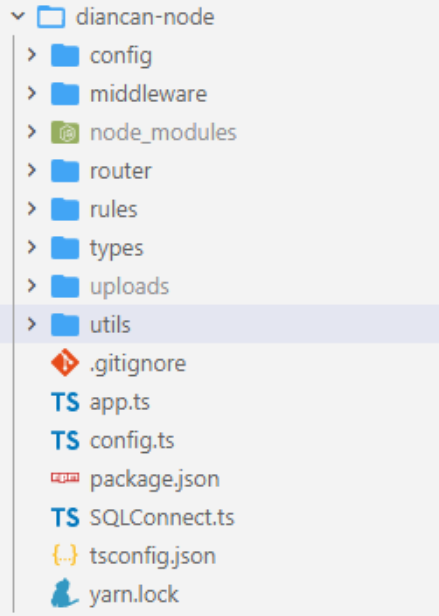二、搭建服务器端
该章节主要 讲解 如何使用 ts + koa2 搭建服务器项目 以及如何去编写全局异常中间件、返回格式中间件、数据校验中间件
2.1 搭建并启动 ts + koa2服务器端
初始化项目
新建diancan-node文件夹 初始化 npm包 npm init -y
项目需要使用的包模块:
koakoa-bodykoa-routerkoa2-corsnodemonasync-validator
构建项目目录

app.ts
ts
import koa from 'koa'
import koaBody from 'koa-body'
import cors from 'koa2-cors'
const app = new koa()
// 跨域处理
app.use(cors())
// 解析post请求 urlencoded | multipart | json 格式
app.use(koaBody())
// 启动服务器
app.listen(5000, () => {
console.log('服务器运行中...')
})
package.json 修改启动命令
json
{
"name": "diancan-node",
"version": "1.0.0",
"description": "",
"main": "index.ts",
"scripts": {
"dev": "nodemon app.ts"
},
"keywords": [],
"author": "",
"license": "ISC"
}
git管理清单
txt
.DS_Store
node_modules/
dist/
uploads/
npm-debug.log*
yarn-debug.log*
yarn-error.log*
package-lock.json
tests/**/coverage/
# Editor directories and files
.idea
.vscode
*.suo
*.ntvs*
*.njsproj
*.sln
tsconfig.json
可通过 tsc --init 一键生成
ts
{
"compilerOptions": {
"target": "es2016",
/* Modules */
"module": "commonjs",
"typeRoots": ["types"],
"esModuleInterop": true,
"forceConsistentCasingInFileNames": true,
"strict": false,
"skipLibCheck": true
}
}
运行项目
执行 yarn dev 或者 npm run dev 项目端口号为5000
2.2 设置全局异常中间件
思路: 捕获异常 try...catch 捕获全局 所有中间件之前执行
config/error.ts
ts
// 错误结构类
class ErrorResult extends Error {
msg: string
code: number
constructor(msg: string, code: number) {
super()
this.msg = msg
this.code = code
}
}
export default ErrorResult
middleware/abnormal.ts
ts
import multer from 'multer'
import { Context, Next } from 'koa'
import ErrorResult from '../config/error'
// 自定义的全局异常处理中间件
const abnormal = (option = {}) => {
return async (ctx: Context, next: Next) => {
try {
// 正常放行 当后续中间件发生错误时 会自动进入catch部分
ctx.error = function(msg: string, code: number) {
throw new ErrorResult(msg, code)
}
await next()
} catch (error) {
console.log(error)
// 发生错误 判断错误的类型【已知错误 | 未知错误】
if (error instanceof ErrorResult) {
// 已知错误
ctx.body = { msg: error.msg, code: error.code }
ctx.status = error.code
} else {
// 未知错误
ctx.body = { msg: '服务器内部错误' }
ctx.status = 500
}
}
}
}
export default abnormal
在 app.ts 中注册 一定要在路由中间件前
ts
import abnormal from './middleware/abnormal'
const app = new koa()
// 跨域处理
app.use(cors())
// 解析post请求 urlencoded | multipart | json 格式
app.use(koaBody())
// 全局异常处理【中间件】
app.use(abnormal())
2.3 响应格式中间件
为了便于调用 将函数添加到ctx全局上下文对象中
middleware/router-response.ts
ts
import { Context, Next } from 'koa'
// 处理响应中间件
const routerResponse = (option = {}) => {
return async function (ctx: Context, next: Next) {
// 成功响应
ctx.success = function (data = null, code = 200, msg = 'SUCCESS') {
ctx.body = { data, code, msg }
}
// 异常响应
ctx.fail = function (msg = 'FAIL', code = 500) {
ctx.body = { code, msg }
}
await next()
}
}
export default routerResponse
在 app.ts 中注册 一定要在路由中间件前
ts
import routerResponse from './middleware/router-response'
const app = new koa()
// 跨域处理
app.use(cors())
// 解析post请求 urlencoded | multipart | json 格式
app.use(koaBody())
// 全局异常处理【中间件】
app.use(abnormal())
// 全局响应结果处理【中间件】
app.use(routerResponse())
2.4 设置ts类型
由于我们为 ctx上下文对象 添加了 error、success、fail 三个属性 所以需要扩展Ctx对象类型
types/index.ts
ts
import 'koa'
import 'koa-router'
declare module 'koa' {
interface DefaultContext {
success: (data?: any, code?: number, msg?: string) => void
error: (msg?: string, code?: number) => void
fail: (msg?: string, code?: number) => void
}
}
declare module 'koa-router' {
interface IRouterParamContext {
success: (data?: any, code?: number, msg?: string) => void
error: (msg?: string, code?: number) => void
fail: (msg?: string, code?: number) => void
}
}
app.ts
ts
import './types'
2.5 前端参数校验中间件
作为后端校验参数字段 是必不可少的内容 在这里我们使用 async-validator 模块进行对象校验
可参考文章: https://blog.csdn.net/dreamingbaobei3/article/details/122727229
middleware/params-validator.ts
ts
import { Context, Next } from 'koa'
import Schema, { Rules } from 'async-validator'
// 验证请求参数中间件
const ParamsValidator = (rules: Rules) => {
return async (ctx: Context, next: Next) => {
try {
// 生成验证规则
const validator = new Schema(rules)
// 根据当前请求类型解析参数值
const data = ['GET', 'DELETE'].includes(ctx.method)
? { ...ctx.query }
: ctx.request.body
// 验证参数值
await validator.validate(data)
// 验证通过
await next()
} catch (error) {
console.log(error)
// 验证失败
ctx.error(error.errors ? error.errors[0].message : error.msg, 500)
}
}
}
export default ParamsValidator